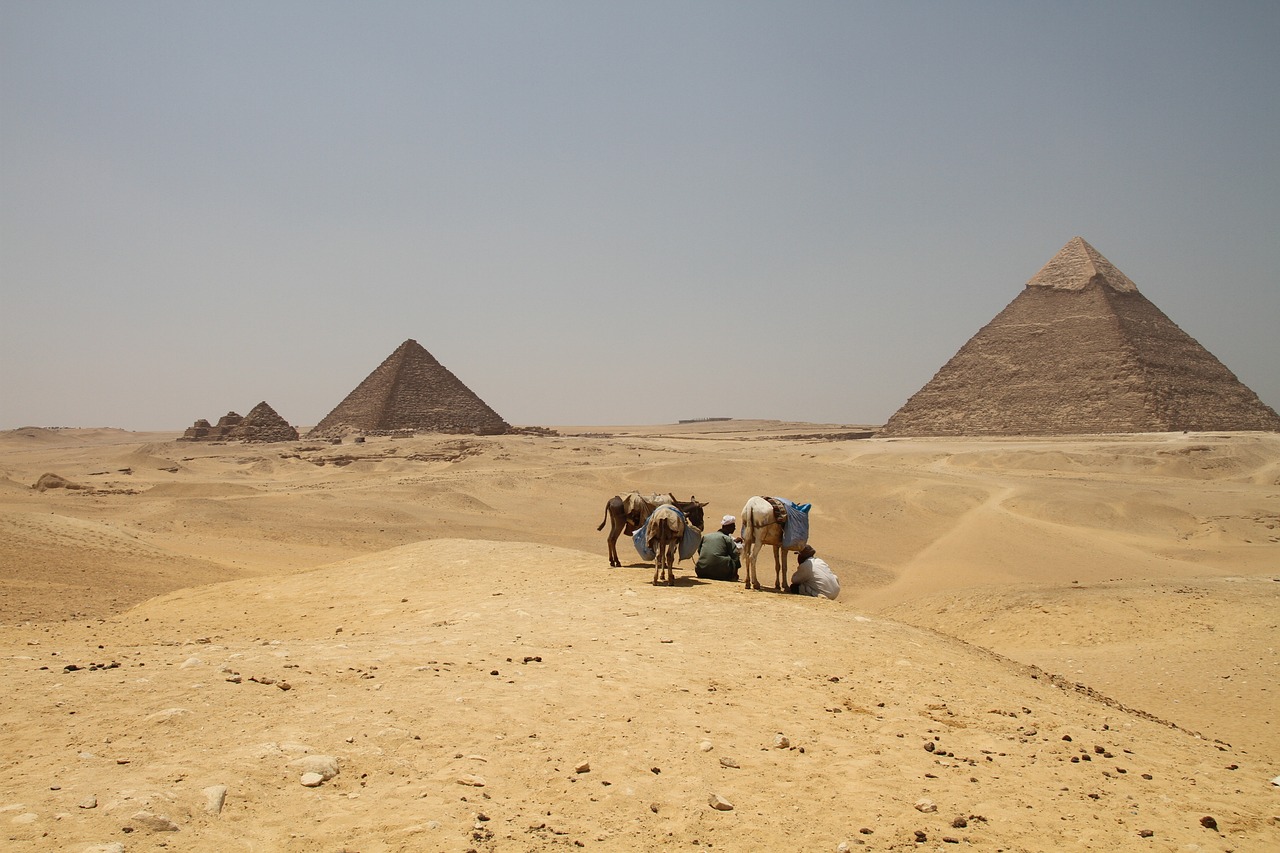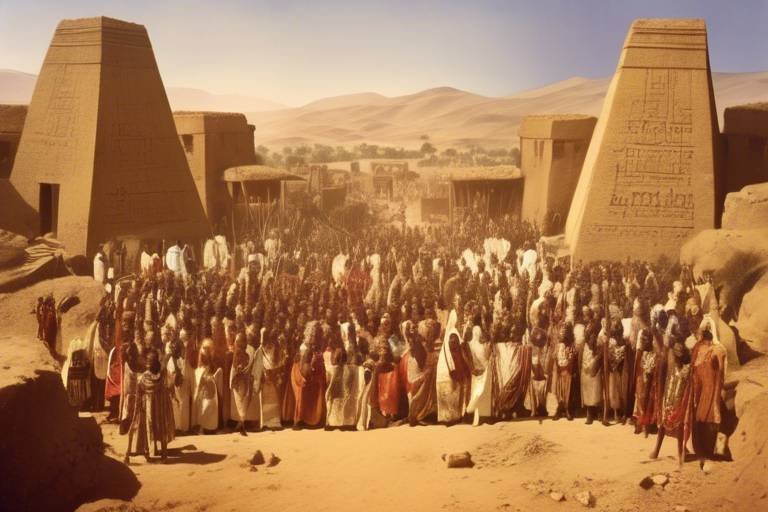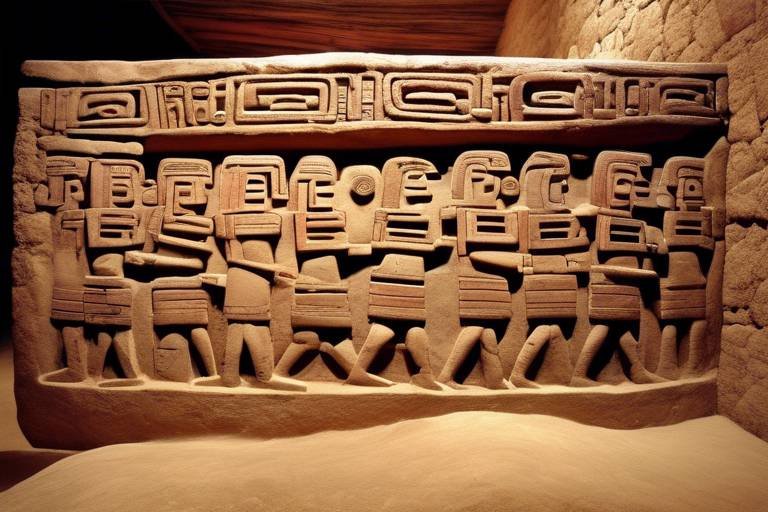The Secrets of the Lost Languages of Ancient Civilizations
Have you ever wondered about the enigmatic languages that have been lost to time, spoken by ancient civilizations whose echoes still resonate in the annals of history? The secrets of the lost languages of ancient civilizations hold a mysterious allure, offering tantalizing glimpses into the cultures, beliefs, and daily lives of those who came before us.
One of the most iconic artifacts that paved the way for deciphering ancient scripts is the Rosetta Stone. This ancient slab of stone played a pivotal role in unlocking the mysteries of Egyptian hieroglyphics, bridging the gap between the past and the present. Through the Rosetta Stone, we have gained invaluable insights into the language and culture of ancient Egypt, reshaping our understanding of the ancient world.
Delving deeper into the realms of lost languages, we encounter the Mayan glyphs, intricate symbols that serve as a window into the rich history of the Mayan civilization. Despite ongoing efforts to decode their meanings, the Mayan glyphs continue to fascinate and perplex, offering tantalizing clues to a civilization shrouded in mystery.
Turning our gaze towards the Indus Valley civilization, we confront the enigma of the Indus script. This undeciphered script has puzzled scholars for decades, sparking debates and theories about its origins and significance. Unraveling the secrets of the Indus script could potentially unlock a treasure trove of knowledge about this ancient civilization.
Exploring the Etruscan inscriptions takes us on a journey into the heart of an enigmatic culture. The unique Etruscan language, preserved in inscriptions scattered across Italy, offers tantalizing glimpses into a civilization that thrived in the shadows of Rome. Deciphering these inscriptions is akin to solving a complex puzzle that could reshape our understanding of ancient Italy.
As we venture into the realm of the Minoan civilization, we encounter the Linear A script, a mysterious writing system that has eluded decipherment for centuries. Unraveling the mysteries of the Linear A script could provide crucial insights into the society and culture of ancient Crete, shedding light on a civilization that flourished in the Aegean.
Exploring the Olmec writing system unveils the legacy of the ancient Americas, where intricate symbols and glyphs offer clues to the beliefs and practices of the Olmec civilization. Decoding the Olmec writing system could rewrite the history books, revealing the interconnectedness of ancient civilizations across the globe.
Investigating the Hittite hieroglyphs leads us to the language of the Anatolian Empire, a powerful civilization that left behind a rich legacy of inscriptions and texts. Deciphering the Hittite hieroglyphs is a key to unlocking the mysteries of this ancient empire, shedding light on its history and cultural achievements.
Diving into the world of cuneiform writing in Mesopotamia uncovers a wealth of lost languages spoken by the Sumerians, Akkadians, Babylonians, and Assyrians. These ancient scripts, etched into clay tablets, hold the key to understanding the complex societies that thrived in Mesopotamia, offering a glimpse into the daily lives and beliefs of our ancestors.

The Rosetta Stone: Deciphering Ancient Scripts
Exploring the mysterious and intriguing languages that have faded into obscurity from ancient civilizations, revealing insights into their cultures, beliefs, and daily lives.
Unveiling the significance of the Rosetta Stone in unlocking the secrets of Egyptian hieroglyphics and its impact on modern understanding of ancient languages.
The discovery of the Rosetta Stone in 1799 by French soldiers in Egypt marked a pivotal moment in the study of ancient scripts. This ancient artifact, inscribed with the same text in three scripts - Ancient Egyptian hieroglyphs, Demotic script, and Ancient Greek - provided the key to deciphering the mysterious hieroglyphic writing system. The Rosetta Stone served as a bridge between the ancient world and the modern era, allowing scholars to unlock the secrets of Egyptian civilization and gain valuable insights into their language, culture, and history.
By comparing the known Ancient Greek text on the Rosetta Stone with the unknown Egyptian scripts, scholars such as Jean-François Champollion were able to crack the code of hieroglyphics. This breakthrough not only revolutionized the field of Egyptology but also opened doors to understanding other ancient languages and scripts that had long been shrouded in mystery.
The Rosetta Stone stands as a testament to human curiosity and perseverance in unraveling the enigmas of the past. Its legacy continues to inspire linguists, archaeologists, and historians in their quest to decode the ancient scripts of lost civilizations and piece together the fragments of our shared human history.

Mayan Glyphs: Symbols of a Lost Civilization
Exploring the mysterious and intriguing languages that have faded into obscurity from ancient civilizations, revealing insights into their cultures, beliefs, and daily lives.
Unveiling the significance of the Rosetta Stone in unlocking the secrets of Egyptian hieroglyphics and its impact on modern understanding of ancient languages.
The Mayan civilization, known for its advanced knowledge in astronomy, mathematics, and architecture, also left behind a complex system of glyphs that have puzzled researchers for centuries. These intricate symbols, carved in stone and painted on pottery, represent a key aspect of the Mayan culture and offer a glimpse into their sophisticated society.
Investigating the undeciphered Indus script of the ancient Indus Valley civilization, discussing theories and challenges surrounding its interpretation and cultural implications.
Exploring the unique Etruscan language and its inscriptions, offering insights into the mysterious Etruscan civilization and the ongoing quest to understand their linguistic heritage.
Unraveling the mysteries of the undeciphered Linear A script of the Minoan civilization, highlighting its significance in understanding the culture and society of ancient Crete.
Examining the enigmatic Olmec writing system and its importance in unraveling the history and beliefs of the Olmec civilization in Mesoamerica.
Investigating the Hittite hieroglyphs of the Anatolian Empire, exploring their role in deciphering the history and culture of this ancient civilization.
Diving into the world of cuneiform writing in Mesopotamia, uncovering the lost languages of ancient Sumerians, Akkadians, Babylonians, and Assyrians, and their enduring legacy.
Q: Are there any known translations of the Mayan glyphs?
A: While some progress has been made in deciphering certain aspects of Mayan glyphs, a complete translation of the entire system remains elusive.
Q: What tools are used to decode ancient scripts like the Indus script?
A: Researchers utilize a combination of linguistic analysis, comparative studies with known languages, and archaeological findings to unravel the meanings behind ancient scripts.
Q: How do modern technologies aid in deciphering ancient languages?
A: Advanced imaging techniques, computer algorithms, and collaborative research efforts have significantly advanced the decipherment of ancient scripts, providing new insights into lost civilizations.

The Indus Script: Enigma of the Indus Valley Civilization
The Indus Script remains one of the most enduring mysteries of the Indus Valley Civilization, a civilization that flourished in the Bronze Age along the Indus River in present-day Pakistan and northwest India. The script, consisting of various symbols and characters, has puzzled archaeologists, linguists, and historians for decades, with its meaning and purpose eluding decipherment.
One of the key challenges in unlocking the secrets of the Indus Script lies in the absence of a bilingual text or a Rosetta Stone-like artifact that could provide a key to understanding the language. Unlike the Egyptian hieroglyphics that were deciphered with the help of the Rosetta Stone, the Indus Script remains a linguistic enigma, with scholars proposing various hypotheses but no definitive conclusions.
Some researchers believe that the Indus Script represents a language, while others argue that it may have served a purely symbolic or decorative purpose. The lack of extensive textual material in the script further complicates efforts to decipher it, leaving many questions unanswered about the communication system of the Indus Valley Civilization.
Despite these challenges, ongoing research and technological advancements offer hope for eventually cracking the code of the Indus Script. Computational analyses, statistical methods, and interdisciplinary collaborations have brought new perspectives to the study of this ancient writing system, bringing us closer to unraveling the linguistic and cultural heritage of the Indus Valley Civilization.

Etruscan Inscriptions: Clues to an Enigmatic Culture
Exploring the unique Etruscan language and its inscriptions provides valuable insights into the mysterious Etruscan civilization, offering clues to their enigmatic culture and societal practices. The Etruscans, who thrived in ancient Italy, left behind a wealth of inscriptions that continue to puzzle historians and archaeologists to this day. These inscriptions, found on various artifacts such as tombs, temples, and pottery, serve as a window into the beliefs, rituals, and daily life of this intriguing civilization.
The Etruscan language, distinct from Latin and other ancient languages, presents a linguistic challenge due to its limited surviving texts and the lack of a comprehensive understanding of its grammar and vocabulary. Scholars have made significant progress in deciphering Etruscan inscriptions, but many aspects of the language remain a mystery, adding to the allure of this ancient culture.
One of the key features of Etruscan inscriptions is their use of a unique script that combines elements of both alphabetic and syllabic writing systems. This hybrid nature of Etruscan writing poses additional challenges in interpreting the texts accurately, requiring a multidisciplinary approach that draws upon linguistic, archaeological, and historical expertise.
Through the study of Etruscan inscriptions, researchers have uncovered references to religious practices, political structures, and social customs of the Etruscan society. These clues provide valuable insights into the organization of Etruscan cities, the role of women in ancient Etruria, and the interactions between the Etruscans and other civilizations in the Mediterranean region.
Despite centuries of scholarly investigation, many aspects of Etruscan culture and language remain shrouded in mystery, fueling ongoing research and debate among experts in the field. The enigmatic nature of Etruscan inscriptions continues to captivate the imagination of historians and enthusiasts alike, offering a tantalizing glimpse into a civilization that left a lasting mark on the ancient world.

The Linear A Script: Minoan Mysteries Unraveled
Exploring the mysterious and intriguing languages that have faded into obscurity from ancient civilizations, revealing insights into their cultures, beliefs, and daily lives.
The Linear A script, originating from the ancient Minoan civilization of Crete, has long been a puzzle for historians and linguists alike. Dating back to the second millennium BCE, this script holds the key to unlocking the mysteries of Minoan society, yet its intricate symbols have confounded researchers for centuries.
Carved on clay tablets and seals, the Linear A script is believed to have been used for administrative and religious purposes, providing a glimpse into the economic and spiritual practices of the Minoans. Despite numerous attempts to decipher its meaning, the script remains largely undeciphered, shrouding the civilization in an aura of enigma.
Some scholars speculate that Linear A may represent a syllabic or ideographic system, similar to its successor, Linear B, which was deciphered in the mid-20th century. However, the lack of a bilingual text or Rosetta Stone equivalent has hindered progress in cracking the code of Linear A, leaving many questions unanswered about the Minoan culture.
Archaeological discoveries, such as the Phaistos Disc, a mysterious clay disk inscribed with undeciphered symbols, continue to fuel interest in the enigmatic script. The intricate nature of the symbols and the absence of a known language related to Linear A pose significant challenges to researchers seeking to unveil its secrets.
As the quest to decipher the Linear A script continues, each new discovery brings us closer to unraveling the mysteries of the ancient Minoan civilization. The tantalizing prospect of understanding their language offers a unique opportunity to peer into the daily lives, beliefs, and societal structures of a civilization lost to time.

The Olmec Writing: Legacy of the Ancient Americas
Exploring the enigmatic Olmec writing system unveils a fascinating legacy of the Ancient Americas. The Olmec civilization, known for its colossal stone heads and advanced culture, left behind a unique script that continues to puzzle researchers and archaeologists to this day. The intricate symbols and glyphs found in Olmec inscriptions offer a glimpse into the beliefs, rituals, and societal structure of this ancient civilization.
Unlike the well-known hieroglyphic scripts of Egypt or Mesopotamia, Olmec writing remains largely undeciphered, adding an air of mystery and intrigue to the study of this ancient culture. Scholars have made significant progress in identifying patterns and recurring symbols in the Olmec script, but a full understanding of its meanings and grammar still eludes experts.
One of the key challenges in deciphering Olmec writing lies in the lack of a bilingual text or Rosetta Stone equivalent that could provide a crucial translation key. Without a direct linguistic link to a known language, researchers must rely on contextual clues, archaeological findings, and comparative studies with other Mesoamerican scripts to piece together the puzzle of the Olmec language.
The significance of unraveling the Olmec script extends beyond linguistic curiosity; it offers a unique opportunity to gain deeper insights into the history and worldview of one of the earliest complex societies in the Americas. By decoding the meanings behind the symbols, researchers hope to shed light on the religious practices, political structures, and cultural exchanges that shaped the Olmec civilization.
As ongoing research and technological advancements continue to enhance our understanding of ancient languages, the legacy of the Olmec writing system remains a testament to the intellectual achievements of the Ancient Americas. The quest to decipher the Olmec script serves as a reminder of the enduring mysteries that lie buried beneath the ruins of past civilizations, waiting to be unearthed and shared with the world.

Hittite Hieroglyphs: Language of the Anatolian Empire
Exploring the ancient Anatolian Empire unveils a fascinating world of Hittite hieroglyphs, a unique language that offers a glimpse into the rich history and culture of this civilization. The intricate symbols and characters carved into stone tablets and monuments present a puzzle waiting to be deciphered, holding the key to understanding the Anatolian Empire's language and society.
The Hittite hieroglyphs, with their intricate designs and mysterious meanings, have captivated archaeologists and linguists for centuries. Scholars have dedicated their careers to unraveling the secrets encoded in these ancient inscriptions, piecing together fragments of a lost language to reconstruct the stories of the Anatolian people.
One of the challenges in deciphering Hittite hieroglyphs lies in the limited number of surviving texts and the complexity of the symbols used. Each symbol represents a sound or a concept, requiring a deep understanding of the Hittite language and culture to interpret accurately. The quest to decode these hieroglyphs is akin to solving a complex puzzle where each piece reveals a small part of the larger picture.
Through the study of Hittite hieroglyphs, researchers have gained valuable insights into the political structures, religious beliefs, and daily life of the Anatolian Empire. The language preserved in these inscriptions provides a direct link to the past, allowing us to glimpse into the minds of ancient Hittite scribes and rulers.
As new discoveries continue to shed light on the Anatolian Empire and its enigmatic hieroglyphs, the quest to unlock the full extent of this ancient language remains ongoing. The Hittite hieroglyphs stand as a testament to the enduring legacy of a civilization that thrived in the heart of Anatolia, leaving behind a linguistic treasure trove waiting to be fully explored and understood.

Lost Languages of Mesopotamia: Cuneiform Chronicles
Delving into the world of ancient Mesopotamia, we uncover a rich tapestry of lost languages preserved in the form of cuneiform script. This intricate writing system, etched into clay tablets, holds the key to unlocking the mysteries of civilizations such as the Sumerians, Akkadians, Babylonians, and Assyrians. Each wedge-shaped symbol tells a story, weaving together the history, culture, and beliefs of these ancient peoples.
Imagine the scribes of Mesopotamia meticulously inscribing these symbols, capturing the essence of their society for future generations to decipher. The cuneiform script served as a bridge to the past, allowing us to peer into the daily lives, religious practices, and political structures of these long-forgotten civilizations.
As we unravel the cuneiform chronicles, we are confronted with a sense of awe and wonder at the sophistication of these ancient languages. The sheer diversity of scripts and dialects reflects the complex tapestry of Mesopotamian society, showcasing the intellectual prowess and cultural richness of these early civilizations.
Through the painstaking efforts of modern archaeologists and linguists, we continue to piece together the fragments of these lost languages, striving to reconstruct the narratives of Mesopotamia's past. Each deciphered tablet brings us closer to understanding the legacy of these ancient peoples and the enduring impact of their linguistic heritage on our modern world.
Frequently Asked Questions
- What is the significance of the Rosetta Stone in deciphering ancient scripts?
The Rosetta Stone played a crucial role in deciphering Egyptian hieroglyphics as it contained inscriptions in three different scripts - hieroglyphic, demotic, and Greek. This enabled scholars to compare the known Greek text with the unknown Egyptian scripts, leading to the translation of ancient Egyptian language and unlocking a wealth of historical knowledge.
- How are Mayan glyphs being decoded?
Mayan glyphs are being decoded through the study of existing inscriptions, comparative analysis with known languages, and advancements in epigraphy and linguistics. Researchers are making progress in understanding the complex system of Mayan writing, which provides insights into the beliefs, rituals, and history of the Mayan civilization.
- What challenges exist in deciphering the Indus script?
The Indus script poses challenges due to the lack of bilingual inscriptions, the absence of a known Rosetta Stone equivalent, and the limited understanding of the Indus Valley civilization. Scholars face difficulties in identifying the language, syntax, and grammar of the script, leading to ongoing debates and multiple hypotheses regarding its interpretation.
- Why is the Linear A script important for understanding Minoan civilization?
The Linear A script is crucial for understanding the Minoan civilization as it provides insights into their administrative, religious, and cultural practices. Deciphering the script can reveal details about trade, governance, and social structure, shedding light on the sophisticated society of ancient Crete.
- What is the legacy of the Olmec writing system in Mesoamerica?
The Olmec writing system holds significance in Mesoamerican history as it represents one of the earliest known writing systems in the region. Studying Olmec inscriptions can unveil the religious beliefs, political structures, and artistic expressions of the Olmec civilization, contributing to our understanding of early American cultures.



















